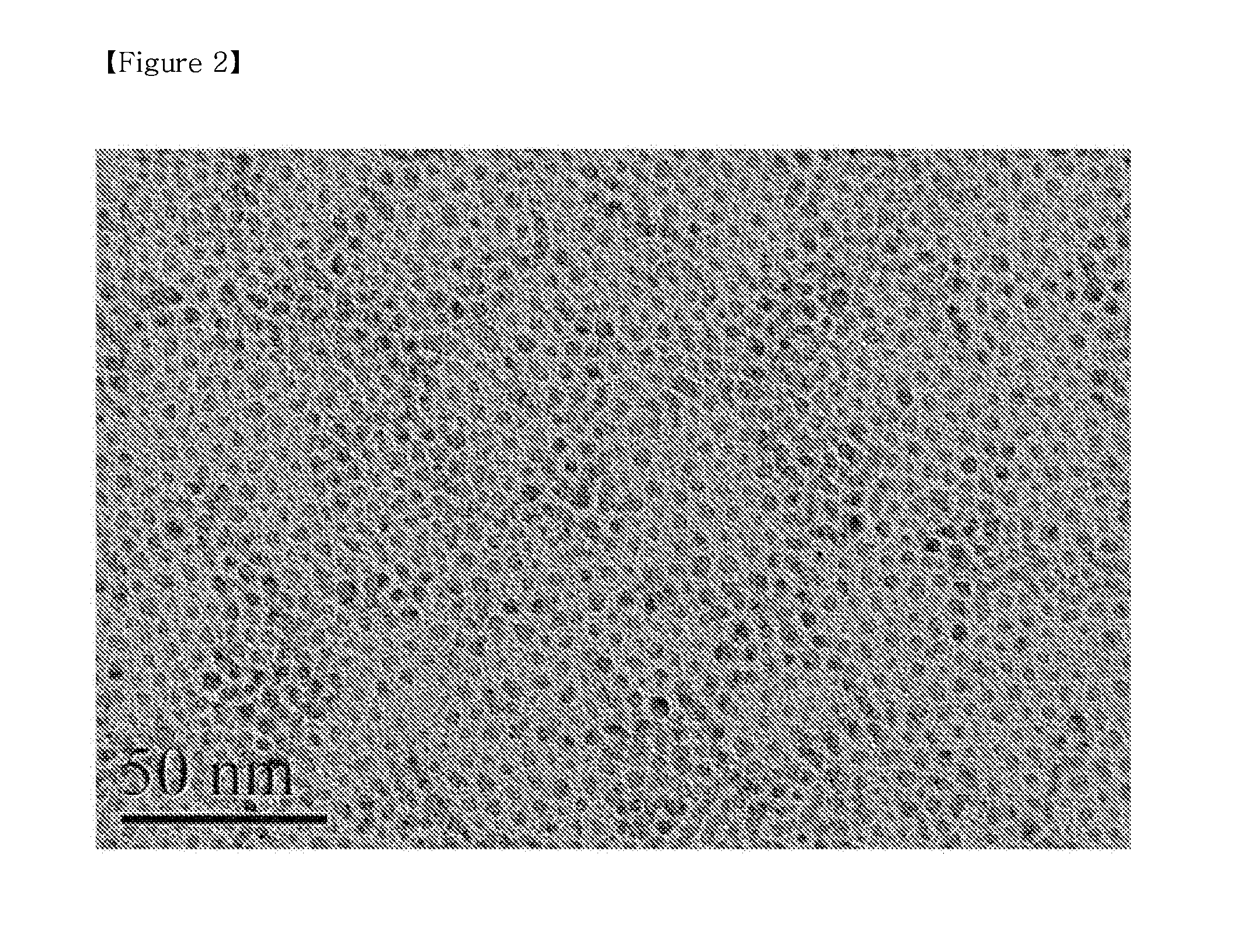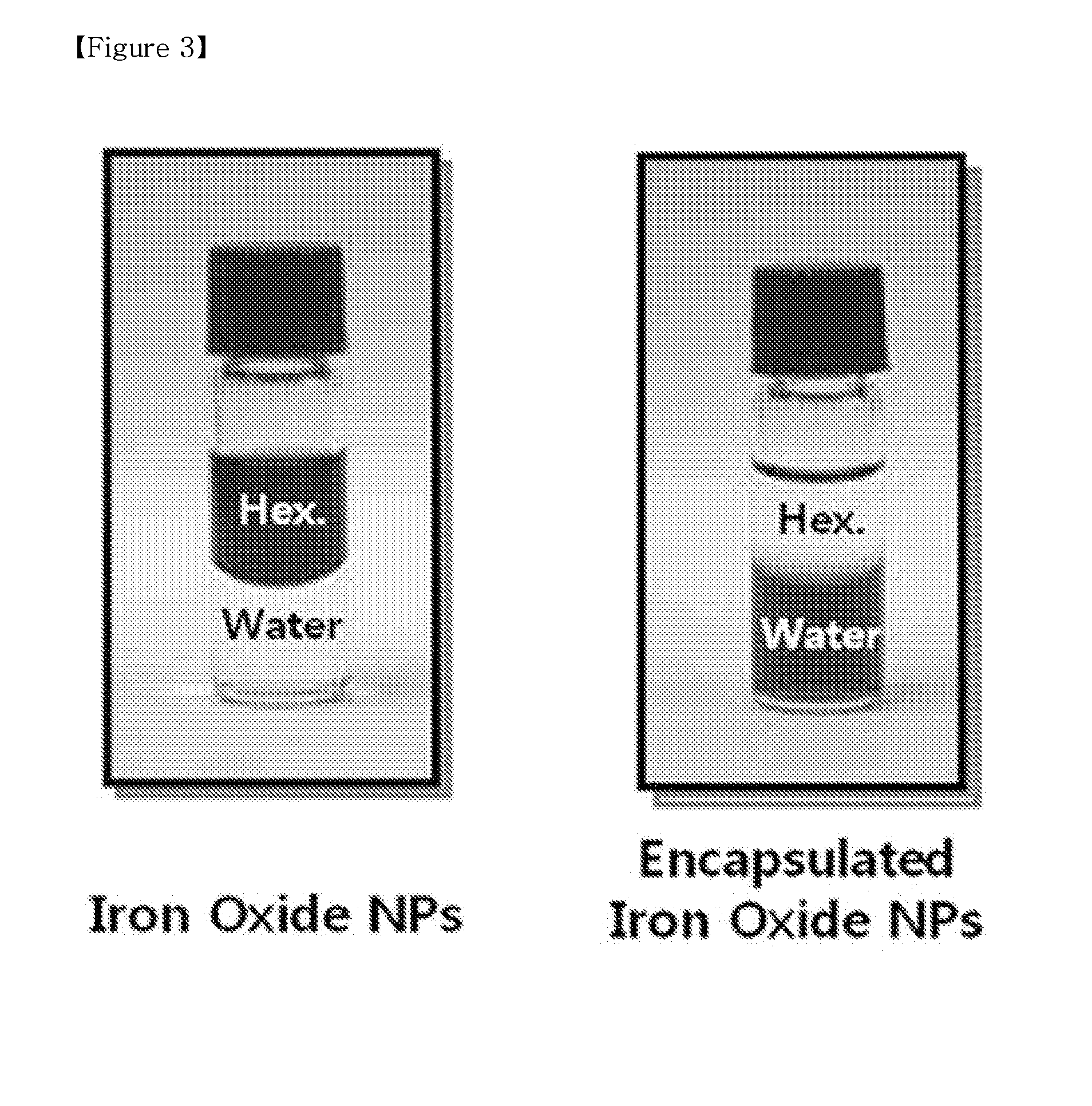Iron oxide nanocapsules, method of manufacturing the same, and MRI contrast agent using the same
- Summary
- Abstract
- Description
- Claims
- Application Information
AI Technical Summary
Benefits of technology
Problems solved by technology
Method used
Image
Examples
example 1
Manufacture of PLGA-Iron Oxide Nanocapsules Using Changes in Solubility of Biodegradable Polymer Solution
[0088]200 mg of PLGA having a carboxyl terminal group and a molecular weight (Mw) of 5,000 was added to 10 ml of ethylacetate and stirred for 10 minutes to completely dissolve it. 200 mg of the monodispersed iron oxide nanoparticles of Preparative Example 1 was added to the above solution and ultra-sonicated at 45° C. for 60 minutes, thus preparing a dispersion solution of iron oxide nanoparticles. When the iron oxide nanoparticles were not completely dispersed in the solvent, an opaque brown color was evident, and most of them precipitated within 5 minutes. On the other hand, in the case where the iron oxide nanoparticles were completely dispersed using ultrasonication, there was a deep transparent black color and precipitation did not occur for ones of days or longer.
[0089]10 ml of the dispersion solution of iron oxide nanoparticles thus prepared was mixed with 20 ml of a 5 wt ...
example 2
Manufacture of PLGA-Iron Oxide Nanocapsules Using Non-Polar Organic Solvent and Distillation
[0091]200 mg of PLGA having a carboxyl terminal group and a molecular weight of 20,000 was added to 150 ml of ethylacetate and stirred for 10 minutes to completely dissolve it, thus preparing a first solution. 200 mg of the monodispersed iron oxide nanoparticles of Preparative Example 1 were added to 100 ml of hexane (a non-polar organic solvent) and ultra-sonicated for 1 hour to completely disperse them, thus preparing a second solution. The first solution and the second solution were mixed together and stirred for 30 minutes, and two solutions were observed to be completely mixed without phase separation.
[0092]The mixture solution comprising the first solution and the second solution was heated to 72° C. higher than the boiling point of hexane and lower than the boiling point of ethylacetate and distilled until the amount of the remaining solution was about 10 ml, thus preparing a dispersio...
example 3
Manufacture of PLGA-Iron Oxide Nanocapsules Having High Encapsulation Efficiency
[0095]Nanocapsules were manufactured in the same manner as in Example 1, with the exception that 40 mg of PLGA, 3 ml of ethylacetate, 200 mg of iron oxide nanoparticles, and 6 ml of 5 wt % aqueous solution of Pluronic F-127 were used, and a stirring rate upon emulsification was 26,000 rpm.
[0096]The PLGA-iron oxide nanocapsules thus manufactured had an average size of 168.9 nm and a size uniformity of 6.4, and were regarded as uniform. In particular, the encapsulation efficiency of iron oxide nanoparticles was 27.4 wt % which was much higher than 7 wt % that was considered to be a threshold due to aggregation of iron oxide nanoparticles in a conventional emulsificaion-diffusion method.
PUM
 Login to View More
Login to View More Abstract
Description
Claims
Application Information
 Login to View More
Login to View More - R&D
- Intellectual Property
- Life Sciences
- Materials
- Tech Scout
- Unparalleled Data Quality
- Higher Quality Content
- 60% Fewer Hallucinations
Browse by: Latest US Patents, China's latest patents, Technical Efficacy Thesaurus, Application Domain, Technology Topic, Popular Technical Reports.
© 2025 PatSnap. All rights reserved.Legal|Privacy policy|Modern Slavery Act Transparency Statement|Sitemap|About US| Contact US: help@patsnap.com



